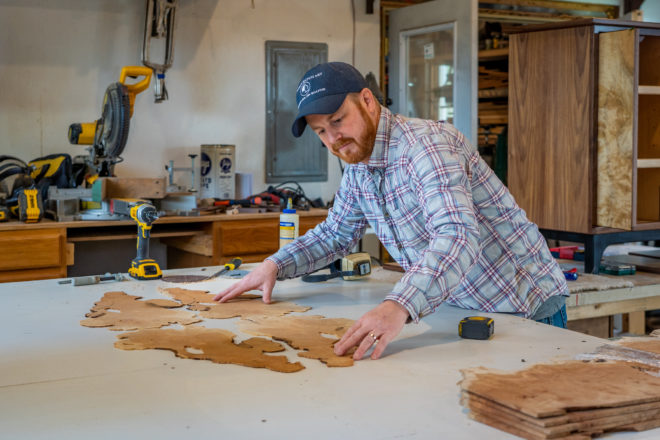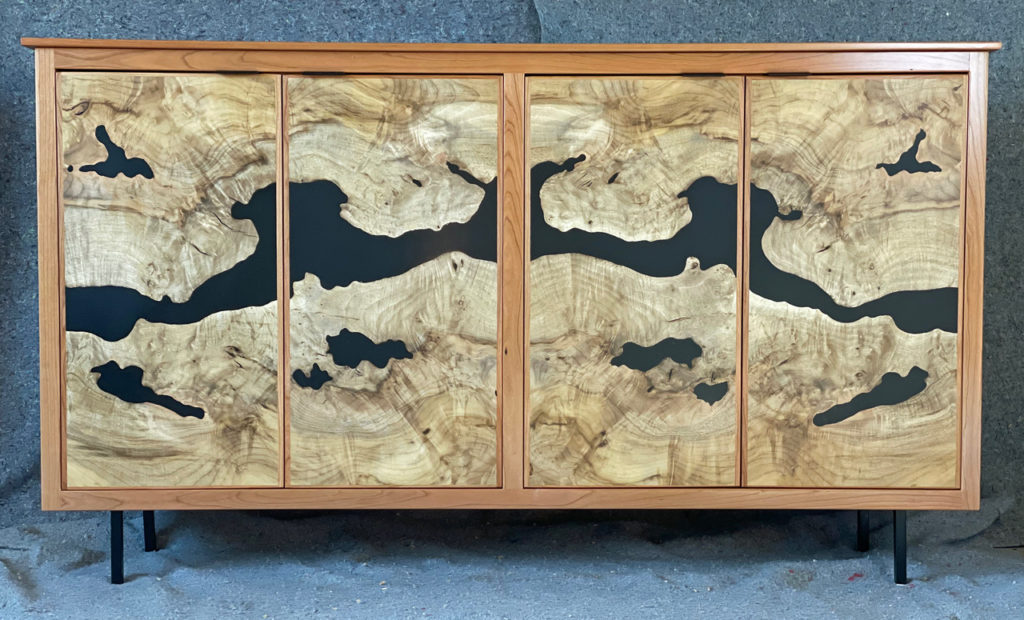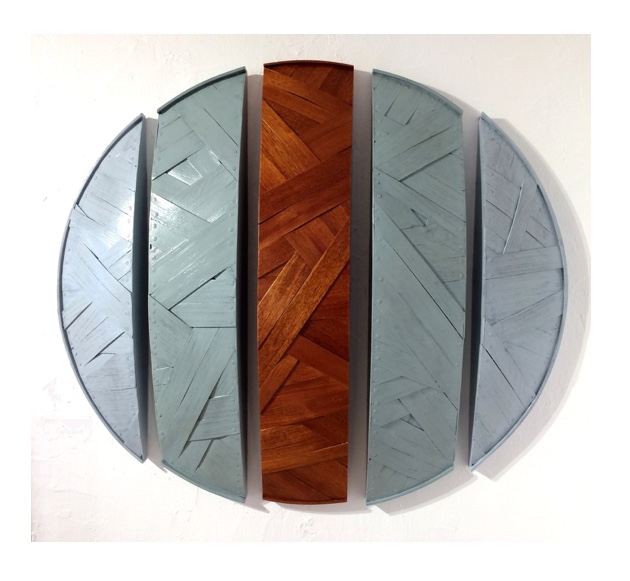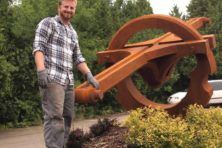A Profile in Wood: Nathan Hatch’s Rorschach Cabinets
- Share
- Tweet
- Pin
- Share

When viewing Nathan Hatch’s Rorschach cabinets, psychological profiling is strictly optional. Is that an empty desert or a life-giving river? Do the shapes of the tulipwood cabinet echo some of Georgia O’Keeffe’s imagery?
Hatch, a wood and metal artist, started working with Rorschach designs in his Baileys Harbor studio just after COVID-19 hit. (As a refresher, the Rorschach test is a psychological test in which subjects’ perceptions of inkblots – which the patterns on Hatch’s furniture mimic – are analyzed to examine the subjects’ personality characteristics and emotional functioning.)
Hatch knew he was going to be home while his now-eight-year-old daughter, Ilayna, home-schooled for months. He understood the process he wanted to undertake; he had the tools and the skills; he’d just never taken the time to develop the idea. At that point, courtesy of COVID-19, he was studio bound and had the time.

Hatch’s design starts with a quarter-inch-thick veneer that he creates through resawing: cutting through a piece of wood to expose the interior as “facing pages.”
His first work involved a piece of myrtlewood with wild, live, curvy edges.
“They didn’t lend themselves to a door or the side of a cabinet, so I needed to mount them on something,” Hatch said. “Once I started arranging panels that could become the ‘skin’ of a cabinet, the negative area in between, when filled with black resin, started to become as interesting as the positive space made by the panel.”
Hatch and J.R. Jarosh at Edgewood Orchard Galleries in Fish Creek began referring to the creations as “Rorschach cabinets.” An inquiry to the University of Wisconsin Law School’s free advice service for state artists indicated that the term was in the public domain, so Hatch could use it in his marketing. He said he has used the technique in about 15 pieces of furniture.

A Life in the Arts
Hatch grew up surrounded by the arts. His mother, Wendy Carpenter, is a well-known fabric artist, and his father, David, is an accomplished fine furniture maker.
At Gibraltar High School, Nathan studied with the highly respected contemporary sculptor Robert Merline, who suggested he continue his studies at UW-Milwaukee. There Hatch studied with sculptor Charles Kraus and learned not only design, but also the nuts and bolts of working with metal – “techniques you would learn at the Neenah Foundry,” Hatch said.
He went to a cast-iron sculpture conference in Birmingham, Alabama, and asked anyone who would talk to him about grad schools. Rather quickly, his long list of potential M.F.A. programs narrowed, and he chose the University of Kentucky, which offered him instructor positions that paid for most of his tuition over three years.
The sculpture program was housed in a big, old tobacco warehouse designed for railcars to roll through.
“It had a lot of room, and everyone got their own studio to work in,” Hatch said.
He didn’t necessarily want to become a studio artist, but coming out of the M.F.A. program at Kentucky, he found that the only open academic positions were short-term, fill-in adjunct posts, so he did some sabbatical substituting at UW-Oshkosh and UW-Green Bay.
“But there wasn’t much money or upward mobility in either of those jobs,” Hatch said. “Being a studio artist was the best bet for me, especially living where we do, where there aren’t any campuses close by.”
There were, however, plenty of appreciative patrons of art and galleries.
Getting started was a long grind nevertheless, Hatch said, but now about 75% of his work is on commission. He sells through Edgewood Orchard Galleries in Door County and Abel Contemporary Gallery near Madison.
Hatch likes to create big, metal sculptures but realizes the market for such large pieces is limited.

“It’s easier for people to incorporate furniture into their lives and home as opposed to a big outdoor sculpture,” he said. “I maybe do one or two of those sculptures a year.”
From the work of Martin Puryear, Hatch gleaned ideas about how to incorporate woodworking into contemporary sculpture.
“I saw what he was doing and realized I have the skillset for building fine furniture, and I should incorporate that into my sculpture,” Hatch said.

The results are reasonably sized, three-dimensional wall pieces. He said that although his work falls into three camps – large-scale sculpture, furniture and wall pieces – the latter is the most personal to him.
“That’s more similar to the work I did in grad school,” he said. “That’s what I would do if I won the lottery and could just do anything.”
But until the lottery finds him, Hatch keeps busy with four or five pieces of furniture in the works, as well as one large sculpture, plus a backgammon board for a client who is collaborating on the colors of the board’s triangles.
“It’s definitely a full schedule,” Hatch said.


